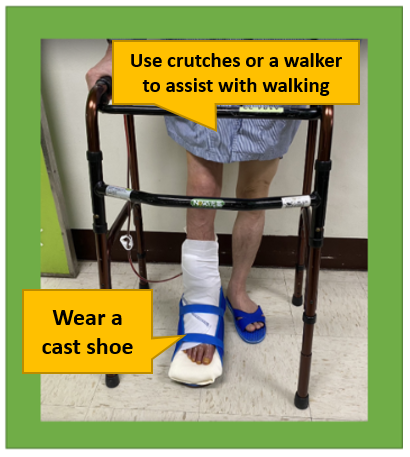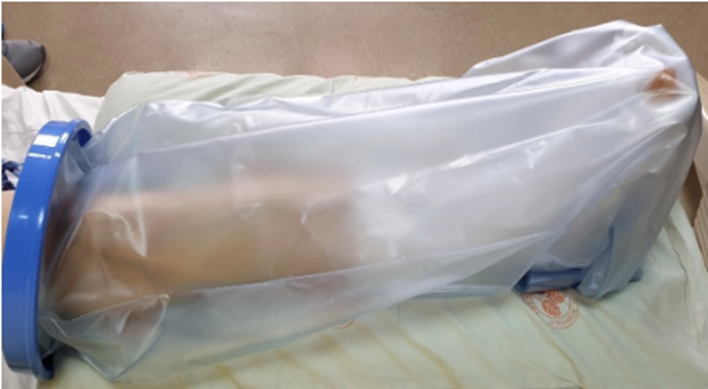【Major points】
- Avoid applying pressure before the plaster is dry, and do not cover it with sheets or clothing.
- When the skin is itchy, do not put anything into the plaster to scratch it.
- When lying in bed, use pillows to elevate the injured limb to reduce swelling.
- Keep the plaster clean and dry, and avoid getting the plaster wet.
- When getting out of bed, you need to wear plaster shoes and use crutches or walkers to assist walking to avoid falling.
Why is the application of a cast necessary?
When a limb is fractured or tendons and ligaments are injured, a cast may be put on before and after surgery to immobilize and protect the injured limb. If the limb is deformed, a cast may be put on to correct or prevent the deformity.
What should I be aware of?
- 10 to 15 minutes after putting on the plaster, you will feel local heat, which is normal. Before the plaster is dry, avoid pressure, do not cover it with sheets or clothes . Do not bear any weight on the cast.
- Keep the edge of the plaster flat to prevent skin damage from friction.
- When the skin is itchy, you can pat the plaster lightly or blow cold air from a hair dryer into the plaster. Never put anything into the plaster to scratch it to avoid skin damage.
- It is necessary to observe whether there is any exudation or blood on the surface of the cast every day. If there are any abnormalities such as swelling, pain, pale skin, cold skin, slow sensation, numbness like a pinprick sensation at the end of the cast limb, please inform the healthcare staff immediately.
- Rehabilitation exercises:
- The limbs with casts need to do muscle contraction exercises. For example, those with lower limbs with casts must do quadriceps exercises. The method is to press down on the knees and contract the thigh muscles to prevent muscle atrophy.
- The joints exposed outside the cast can perform joint activities after the medical staff's instructions to maintain their maximum range of motion, such as joint movements of toes or fingers.
- Precautions for bed rest and activities:
- When lying down, elevate the casted limb with a pillow to promote blood circulation and reduce swelling.
- For upper limb casts, when getting out of bed, support the casted limb with your uninvolved hand or use an arm sling as instructed by the physician.
- For lower limb casts, wear a cast shoe when getting out of bed to keep the cast clean. Use crutches or a walker to assist with walking and prevent slipping (see Figure 1).
- Patients with lower limb casts may experience congestion and swelling when getting out of bed. Therefore, gradually increase the time spent out of bed and elevate the casted limb during rest periods to alleviate swelling.
Figure 1
For patients with lower limb casts, when getting out of bed, it is essential to wear a cast shoe and use crutches or a walker to assist with walking.

For patients with lower limb casts, when getting out of bed, it is essential to wear a cast shoe and use crutches or a walker to assist with walking.

Home Care
- The cast should be kept clean and dry. When bathing, tightly wrap the limb with a plastic bag or use a cast waterproof cover (see Figure 2) to prevent it from getting wet. Avoid wetting the cast, but if it accidentally gets wet, you can use a hairdryer on a cool setting to dry it.
Figure 2
Cast Waterproof Cover
-
It is important to keep the casted limb elevated to reduce swelling and continue performing the rehabilitation exercises taught during your hospital stay.
-
Do not insert any objects into the cast, and do not attempt to remove the cast yourself, as it may interfere with the effectiveness of the treatment.
-
If you experience any of the following abnormalities, please seek immediate follow-up at the orthopedic clinic:
-
Unusual swelling, sharp pain, numbness, or a sensation of coldness in the casted upper limb.
-
Cast breakage or loosening.
-
Sensation of heat or an unusual odor within the cast.
-
Post-cast removal considerations:
- When the cast is being removed with a saw, you may feel vibrations and pressure, but it will not cut the skin, so there's no need to worry.
- After cast removal, the skin may be dry and flaky, which can be cleaned with mild soap and lukewarm water.
- Following cast removal, you may experience muscle weakness and joint stiffness. It's essential to gradually increase the activity of the affected limb.
References
- Althoff, A. D., & Reeves, R. A. (2021). Splinting. In StatPearls. https://www.ncbi.nlm.nih.gov/pubmed/32491605
- Nemeth, B., & Cannegieter, S. C. (2019). Venous thrombosis following lower-leg cast immobilization and knee arthroscopy: from a population-based approach to individualized therapy. Thrombosis research, 174, 62-75. https://doi.org/10.1016/j.thromres.2018.11.030
- Paula, S.(2023). Patient education: Cast and splint care (Beyond the Basics). UpToDate. https://www.uptodate.com/contents/cast-and-splint-care-beyond-the-basics
- Piyapittayanun, P., Mutthakalin, K., Arirachakaran, A., & Kongtharvonskul, J. (2019). Comparative outcomes of foot cast and short leg cast in pseudo-Jones avulsion fracture: a single blinded randomized controlled trial. Journal of foot and ankle research, 12(1), 1-8. https://dx.doi.org/10.1186%2Fs13047-019-0359-5
Quiz
Please answer the following questions:
Nursing Instruction Satisfaction
Please log in to rate
- Location
-
- Category
- Self-care / Home Care

